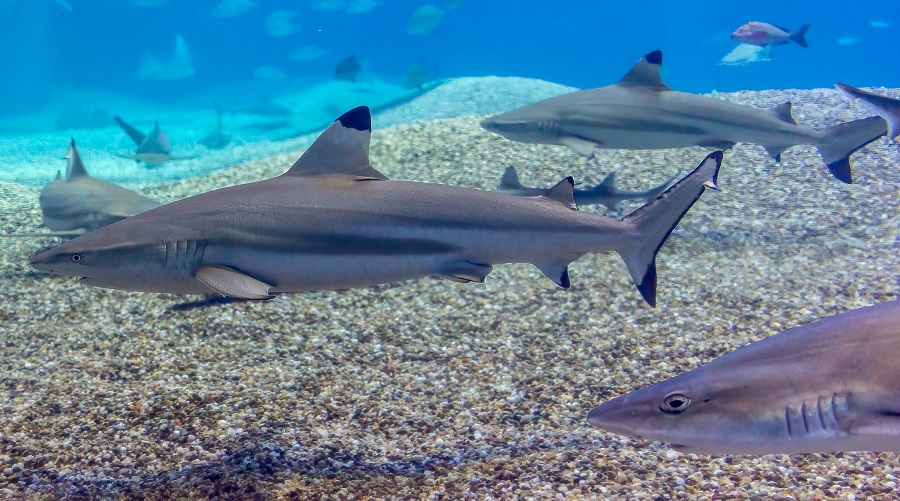
Blacktip reef shark. Photo by Ray in Manila, Flickr.
Urea – the main component of human urine – plays an important role in the timing of maturation of sharks, rays and other cartilaginous fish.
A new study by researchers with the Sea Around Us initiative at the University of British Columbia’s Institute for the Oceans and Fisheries found that high urea concentrations common in cartilaginous fish, particularly oviparous marine species, allow them to mature and begin to reproduce at a larger fraction of their maximal size.
“It has long been known that cartilaginous fish are late to mature compared to bony fish but our results provide a mechanistic reason as to why this is the case,” said Melanie Warren, who led the study while completing her master’s degree at UBC. “Our findings are important because these fishes are very susceptible to fishing pressure. If they are caught in high numbers before they have had a chance to reproduce, populations are decimated and this is why we see today that 37 per cent of sharks, rays, skates and sawfish are threatened with extinction. Therefore, knowing when they mature is key to sustainable fisheries management and conservation efforts.”
Warren and co-author Dr. Daniel Pauly, principal investigator of the Sea Around Us, analyzed published data on the average length at first maturity and maximum length of almost 1000 species of cartilaginous fish. They then estimated the fishes’ metabolic rate at both sizes and combining the two figures for each species, computed their ‘reproductive respiratory threshold’ (RRT). Previous studies have shown that when such a value is reached, maturation and spawning are triggered.
The researchers found notable differences when comparing their results to the ‘1.36 threshold’ estimated for hundreds of marine and freshwater bony fish and invertebrates.
The two extremes that caught their attention the most were the ‘1.13 threshold’ estimated for marine oviparous sharks and rays, and the ‘1.33 threshold’ estimated for freshwater viviparous rays.
“These thresholds tell us that oviparous sharks and rays mature at a greater fraction of their maximum size than freshwater viviparous rays or bony fish,” Warren said. “In other words, if gray snappers mature when they reach 40-50 per cent of their maximum length, blacktip sawtail catsharks mature when they reach about 60-70 per cent of their maximum size.”
After estimating these thresholds, the researchers started looking at their connection to urea retention, as it is known that many cartilaginous species concentrate high levels of urea within their body tissues and fluids to prevent excessive loss of water.
“We found that species with high urea retention mature at a greater fraction of their maximum size than species that retain little urea,” Warren said. “This was a ‘urea-ka’ moment.”
The researchers hypothesized that urea, known to aid in acid-base regulation in cartilaginous fish, acts as a buffer against the acidity that is caused by the reduced oxygen intake caused by growth and the ensuing reduction of oxygen supply.
“When fish grow, their two-dimensional gills or respiratory organs have difficulties providing oxygen to their developing tri-dimensional bodies. This reduced oxygen intake affects the rate at which proteins – essential components of fish’s cells and tissues – are naturally degraded or ‘denatured’ and resynthesized so the organism remains alive. There is a point at which the oxygen required for growth and for the re-synthesis of denatured proteins becomes very tight and creates an acidic internal environment that ‘tells’ fish that it is time to self-regulate and release a hormonal cascade that halts growths, triggers spawning and allows them to breathe in more oxygen,” Dr. Pauly explained.
Although this process also applies to cartilaginous fish, their urea retention balances out the acidity caused by reduced oxygen intake and allows them to continue growing for longer than bony fish and delay maturation.
“Interestingly, this doesn’t happen with viviparous freshwater rays, whose threshold is closer to that of bony fish, as they provide their pups with oxygen through their gills and, thus, experience greater oxygen stress than marine oviparous rays,” Dr. Pauly said. “And, even more interestingly, it has been shown that viviparous freshwater rays have almost completely lost the ability to retain urea. This strengthens the link between respiration, urea retention and the attainment of first maturity in cartilaginous fish.”
The paper “The likely role of urea in delaying the size at first maturity of ureosmotic Chondrichthyes” was published in Environmental Biology of Fishes https://doi.org/10.1007/s10641-024-01548-9


